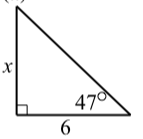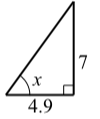3.E: Triangles and Vectors (Exercises)
( \newcommand{\kernel}{\mathrm{null}\,}\)
Exercise 3.E.1
In each of the following, the coordinates of a point P on the terminal side of an angle θ are given. For each of the following:
Plot the point P in a coordinate system and draw the terminal side of the angle.
Determine the radius r of the circle centered at the origin that passes through the point P.
Determine the values of the six trigonometric functions of the angle θ.
- P(3,3)
- P(5,8)
- P(−2,−2)
- P(5,−2)
- P(−1,−4)
- P(2√3,2)
- P(−3,4)
- P(3,−3√3)
- P(2,−1)
- Answer
-
(a) We see that r=√32+32=√18. So
cos(θ)=3√18=33√2=1√2
tan(θ)=33=1
sec(θ)=√183=√2
sin(θ)=3√18=33√2=1√2
cot(θ)=33=1
csc(θ)=√183=√2
(b)
We see that r=√52+82=√89. So
cos(θ)=5√89
tan(θ)=85
sec(θ)=√895
sin(θ)=8√89
cot(θ)=58=1
csc(θ)=√898
(e)
We see that r=√(−1)2+(−4)2=√26. So
cos(θ)=−3√26
tan(θ)=4
sec(θ)=−√264
sin(θ)=−3√26
cot(θ)=14=1
csc(θ)=−√26
Exercise 3.E.2
For each of the following, draw the terminal side of the indicated angle on a coordinate system and determine the values of the six trigonometric functions of that angle
- The terminal side of the angle α is in the first quadrant and sin(α)=1√3
- The terminal side of the angle β is in the second quadrant and cos(β)=−23
- The terminal side of the angle γ is in the second quadrant and tan(γ)=−12
- The terminal side of the angle θ is in the second quadrant and sin(θ)=13
- Answer
-
2. We first use the Pythagorean Identity and obtain sin2(β)=59. Since the terminal side of β is in the second quadrant, sin(β)=√53. In addition,
tan(β)=−√52
cot(β)=−2√5
sec(β)=−32
csc(β)=3√5
Exercise 3.E.3
For each of the following, determine an approximation for the angle θ in degrees (to three decimal places) when 0∘≤θ≤360∘.
- The point (3,5) is on the terminal side of θ.
- The point (2,−4) is on the terminal side of θ.
- sin(θ)=23 and the terminal side of θ is in the second quadrant.
- sin(θ)=−23 and the terminal side of θ is in the fourth quadrant.
- cos(θ)=−14 and the terminal side of θ is in the second quadrant.
- cos(θ)=−34 and the terminal side of θ is in the third quadrant.
- Answer
-
3. Since the terminal side of θ is in the second quadrant, θ is not the inverse sine of 23. So we let α=arcsin(23). Using α as the reference angle, we then see that θ=180∘−arcsin(23)≈138.190∘
5. θ=arccos(−14)≈104.478∘, or use \(\alpha\ = \arccos(\dfrac{1}{4})) for the reference angle.
θ=180∘−arccos(14)≈104.478∘.
Exercise 3.E.4
For each of the angles in Exercise (3), determine the radian measure of θ if 0≤θ≤2π.
- Answer
-
3. θ=π−arcsin(23)≈2.142.
5. θ=π−arccos(14)≈1.823.
Exercise 3.E.5
Determine the exact value of each of the following. Check all results with a calculator.
- cos(arcsin(15))
- tan(cos−1(23))
- sin(tan−1(2))
- cos(arcsin(−15))
- sin(arccos(−35))
- Answer
-
2. Let θ=cos−1(23). Then cos(θ)=23 and 0≤θ≤π. So sin(θ)>0 and sin2(θ)=1−cos2(θ)=59. So
tan(cos−1(23))=tan(θ)=sin(θ)cos(θ)=√5323=√52
Using a calculator, we obtain
tan(cos−1(23))≈1.11803 and √52≈1.11803
Exercise 3.E.6
For each of the following right triangles, determine the value of x correct to the nearest thousandth.
- Answer
-
- x=6tan(47∘)≈6.434.
- x=3.1cos(67∘)≈1.211.
- x=tan−1(74.9)≈55.008∘.
- x=sin−1(79.5)≈47.463∘.
Exercise 3.E.7
One angle in a right triangle is 55∘ and the side opposite that angle is 10 feet long. Determine the length of the other side, the length of the hypotenuse, and the measure of the other acute angle.
Exercise 3.E.8
One angle in a right triangle is 37.8∘ and the length of the hypotenuse is 25 inches. Determine the length of the other two sides of the right triangle.
Exercise 3.E.9
One angle in a right triangle is 27∘12′ and the length of the side adjacent to this angle is 4 feet. Determine the other acute angle in the triangle, the length of the side opposite this angle, and the length of the hypotenuse.
Note: The notation means that the angle is 27 degrees, 12 seconds. Remember that 1 second is 160 of a degree.
- Answer
-
The other acute angle is 64∘48′.
The side opposite the 27∘12′ angle is 4tan(27∘12′)≈2.056 feet. - The hypotenuse is 4cos(27∘12′)≈4.497 feet.
Note that the Pythagorean Theorem can be used to check the results by showing that 42+2.0562≈4.4972. The check will not be exact because the 2.056 and 4.497 are approximations of the exact values.
Exercise 3.E.10
If we only know the measures of the three angles of a right triangle, ex- plain why it is not possible to determine the lengths of the sides of this right triangle.
Exercise 3.E.11
Suppose that we know the measure θ of one of the acute angles in a right triangle and we know the length x of the side opposite the angle θ. Explain how to determine the length of the side adjacent to the angle θ and the length of the hypotenuse.
Exercise 3.E.12
In the diagram to the right, determine the values of a, b, and h to the nearest thousandth.
The given values are:
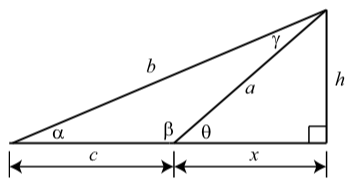
Figure 3.E.1
α=23∘
β=140∘
c=8
- Answer
-
We first note that θ=40∘. We use the following two equations to determine x.
tan(α)=hc+x tan(x)=hx
Substituting h=xtan(θ) into the first equation and solving for x gives x=ctan(α)tan(θ)−tan(α)≈8.190.
We can then use right triangles to obtain h≈6.872 ft,a≈10.691 ft,andb≈17.588 ft
Exercise 3.E.13
A tall evergreen tree has been damaged in a strong wind. The top of the tree is cracked and bent over, touching the ground as if the trunk were hinged. The tip of the tree touches the ground 20 feet 6 inches from the base of the tree (where the tree and the ground meet). The tip of the tree forms an angle of 17 degrees where it touches the ground. Determine the original height of the tree (before it broke) to the nearest tenth of a foot. Assume the base of the tree is perpendicular to the ground.
Exercise 3.E.14
Suppose a person is standing on the top of a building and that she has an instrument that allows her to measure angles of depression. There are two points that are 100 feet apart and lie on a straight line that is perpendicular to the base of the building.
Now suppose that she measures the angle of depression to the closest point to be 35.5∘ and that she measures the angle of depression to the other point to be 29.8∘. Determine the height of the building.
Exercise 3.E.15
A company has a 35 foot ladder that it uses for cleaning the windows in their building. For safety reasons, the ladder must never make an angle of more than 50∘ with the ground.
- What is the greatest height that the ladder can reach on the building if the angle it makes with the ground is no more than 50∘.
- Suppose the building is 40 feet high. Again, following the safety guidelines, what length of ladder is needed in order to have the ladder reach the top of the building?
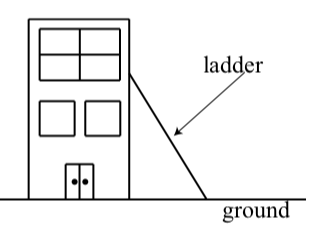
Figure 3.E.2
Note
For Exercises 3.E.16 through 3.E.19, use the Law of Sines.
Exercise 3.E.16
Two angles of a triangle are 42∘ and 73∘. The side opposite the 73∘ angle is 6.5 feet long. Determine the third angle of the triangle and the lengths of the other two sides.
- Answer
-
The third angle is 65∘. The side opposite the 42∘ angle is 4.548 feet long. The side opposite the 65∘ angle is 6.160 feet long.
Exercise 3.E.17
A triangle has a side that is 4.5 meters long and this side is adjacent to an angle of 110∘. In addition, the side opposite the 110∘ angle is 8 meters long. Determine the other two angles of the triangle and the length of the third side.
Exercise 3.E.18
A triangle has a side that is 5 inches long that is adjacent to an angle of 61∘. The side opposite the 61∘ angle is 4.5 inches long. Determine the other two angles of the triangle and the length of the third side.
- Answer
-
There are two triangles that satisfy these conditions. The sine of the angle opposite the 5 inch side is approximately 0.9717997.
Exercise 3.E.19
In a given triangle, the side opposite an angle of 107∘ is 18 inches long. One of the sides adjacent to the 107∘ angle is 15.5 inches long. Determine the other two angles of the triangle and the length of the third side.
Note
For Exercises 3.E.20 through 3.E.21, use the Law of Cosines.
Exercise 3.E.20
The three sides of a triangle are 9 feet long, 5 feet long, and 7 feet long. Determine the three angles of the triangle.
- Answer
-
The angle opposite the 9 foot long side is 95.739∘. The angle opposite the 7 foot long side is 50.704∘. The angle opposite the 5 foot long side is 33.557∘.
Exercise 3.E.21
A triangle has two sides of lengths 8.5 meters and 6.8 meters. The angle formed by these two sides is 102∘. Determine the length of the third side and the other two angles of the triangle
Note
For the remaining exercises, use an appropriate method to solve the problem.
Exercise 3.E.22
Two angles of a triangle are 81.5∘ and 34∘. The length of the side opposite the third angle is 8.8 feet. Determine the third angle and the lengths of the other two sides of the triangle.
Exercise 3.E.23
In the diagram below, determine the value of γ (to the nearest hundredth of a degree) and determine the values of h and d (to the nearest thousandth) if it is given that a=4b=8c=10θ=26∘
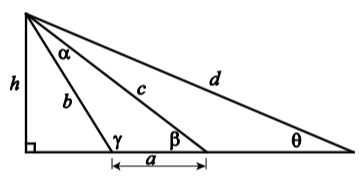
Figure 3.E.3
Exercise 3.E.24
In the diagram below, it is given that:
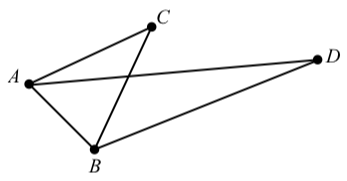
Figure 3.E.4
- The length of AC is 2.
- The length of BC is 2.
- ∠ACB=40∘
- ∠CAD=20∘
- ∠CBD=45∘
Determine the lengths of AB and AD to the nearest thousandth.
Exercise 3.E.25
A ski lift is to be built along the side of a mountain from point A to point B in the following diagram. We wish to determine the length of this ski lift.
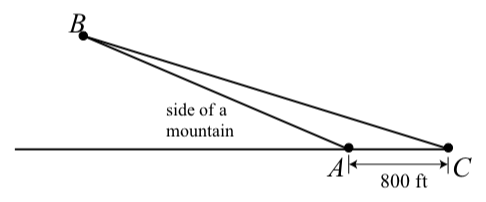
Figure 3.E.5
A surveyor determines the measurement of angle BAC to be 155.6∘ and then measures a distance of 800 ft from Point A to Point C. Finally, she determines the measurement of angle BCA to be 17.2∘. What is the the length of the ski lift (from point A to point B)?
- Answer
-
The ski lift is about 1887.50 feet long.
Exercise 3.E.26
A boat sails from Muskegon bound for Chicago, a sailing distance of 121 miles. The boat maintains a constant speed of 15 miles per hour. After encountering high cross winds the crew finds itself off course by 20∘ after 4 hours. A crude picture is shown in the following diagram, where α=20∘.
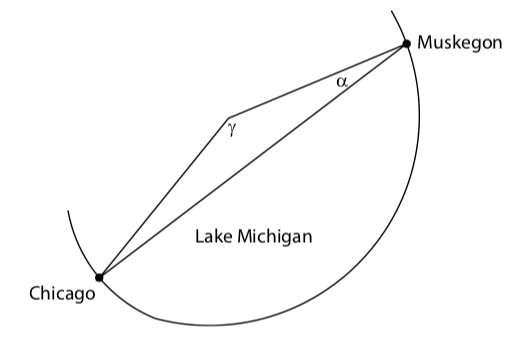
Figure 3.E.6
- How far is the sailboat from Chicago at this time?
- What is the degree measure of the angle γ (to the nearest tenth) in the diagram? Through what angle should the boat turn to correct its course and be heading straight to Chicago?
- Assuming the boat maintains a speed of 15 miles per hour, how much time have they added to their trip by being off course?
- Answer
-
- The boat is about 67.8 miles from Chicage.
- γ≈142.4∘. So the boat should turn through an angle of about 180∘−142.4∘=37.6∘
- The direct trip from Muskegon to Chicago would take 12115 hours or about 8.07 hours. By going off-course, the trip now will take 127.815 hours or about 8.52 hours.
Exercise 3.E.27
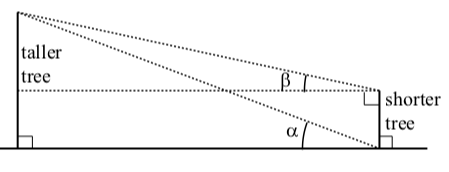
Figure 3.E.7
Two trees are on opposite sides of a river. It is known that the height taller of the shorter of the two trees is 13 meters. A person makes the following angle measurements:
The angle of elevation from the base of the shorter tree to the top of the taller tree is α=20∘.
The angle of elevation from the top of the shorter tree to the top of the taller tree is β=12∘.
Determine the distance between the bases of the two trees and the height of the taller tree.
Exercise 3.E.28
One of the original Seven Wonders of the World, the Great Pyramid of Giza (also known as the Pyramid of Khufu or the Pyramid of Cheops), was believed to have been built in a 10 to 20 year period concluding around 2560 B.C.E. It is also believed that the original height of the pyramid was 146.5 meters but that it is now shorter due to erosion and the loss of some topmost stones.
To determine its current height, the angle of elevation from a distance of 30 meters from the base of the pyramid was measured to be 46.12∘, and then the angle of elevation was measured to be 40.33∘ from a distance of 60 meters from the base of the pyramid as shown in the following diagram. Use this information to determine the height h of the pyramid. (138.8 meters)
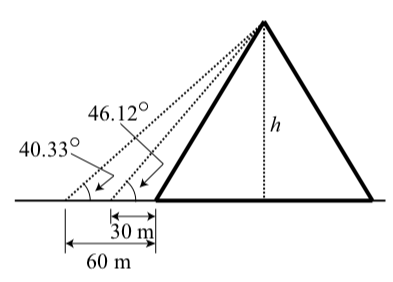
Figure 3.E.8
Exercise 3.E.29
Two sides of a triangle have length 2.5 meters and 3.5 meters, and the angle formed by these two sides has a measure of 60∘. Determine the area of the triangle. Note: This is the triangle in Progress Check 3.17 on page 200.
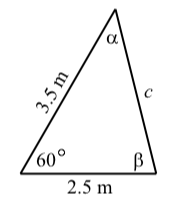
Figure 3.E.9
Exercise 3.E.30
A field has the shape of a quadrilateral that is not a parallelogram. As shown in the following diagram, three sides measure 50 yards, 60 yards, and 70 yards. Due to some wetland along the fourth side, the length of the fourth side could not be measured directly. The two angles shown in the diagram measure 127∘ and 132∘.
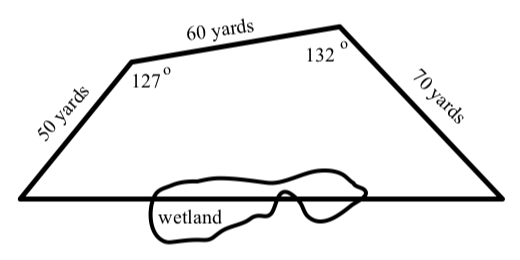
Figure 3.E.10
Determine the length of the fourth side of the quadrilateral, the measures of the other two angles in the quadrilateral, and the area of the quadrilateral. Lengths must be accurate to the nearest hundredth of a yard, angle measures must be correct to the nearest hundredth of a degree, and the area must be correct to the nearest hundredth of a square yard.
Exercise 3.E.31
In each of the following diagrams, one of the vectors u, v, and u+v is labeled. Label the vectors the other two vectors to make the diagram a valid representation of u+v
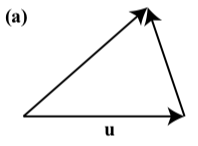
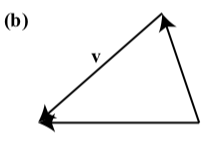
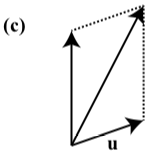
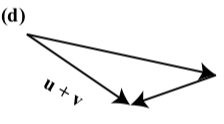
- Answer
-

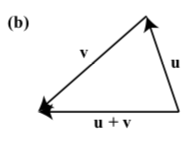
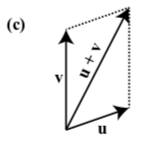
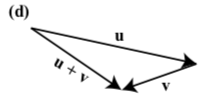
Exercise 3.E.32
On the following diagram, draw the vectors u+v, u−v, 2u+v, and 2u−v.

Figure 3.E.11
- Answer
-
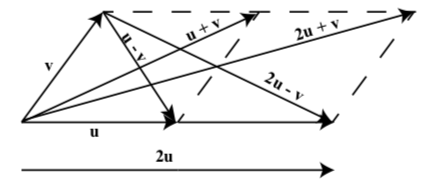
Figure 3.E.12
Exercise 3.E.33
In the following diagram, |a|=10 and |a|+|b|=14. In addition, the angle θ between the vectors a and b is 30∘. Determine the magnitude of the vector b and the angle between the vectors a and a+b.

Figure 3.E.13
- Answer
-
The angle between the vectors a and a+b is approximately 9.075∘. In addition, |b|≈4.416.
Exercise 3.E.34
Suppose that vectors a and b have magnitudes of 125 and 180, respectively. Also assume that the angle between these two vectors is 35∘. Determine the magnitude of the vector a+b and the measure of the angle between the vectors a and a+b.
Exercise 3.E.35
A car that weighs 3250 pounds is on an inclined plane that makes an angle of 4.5∘ with the horizontal. Determine the magnitude of the force of the car on the inclined plane, and determine the magnitude of the force on the car down the plane due to gravity. What is the magnitude of the smallest force necessary to keep the car from rolling down the plane?
Exercise 3.E.36
An experiment determined that a force of 45 pounds is necessary to keep a 250 pound object from sliding down an inclined plane. Determine the angle the inclined plane makes with the horizontal.
Exercise 3.E.37
A cable that can withstand a force of 4500 pounds is used to pull an object up an inclined plane that makes an angle of 15 degrees with the horizontal. What is the heaviest object that can be pulled up this plane with the cable? (Assume that friction can be ignored.)
Exercise 3.E.38
Determine the magnitude and the direction angle of each of the following vectors.
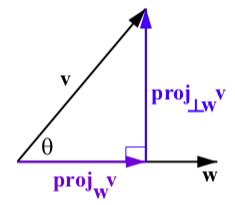
Figure 3.E.14: The Projection of v onto w
- v=3i+5j
- w=⟨−3,6⟩
- a=4i−7j
- u=⟨−3,−5⟩
- Answer
-
- |v|=√34. The direction angle is approximately 59.036∘.
- |w|=√45. The direction angle is approximately 116.565∘.
Exercise 3.E.39
Determine the horizontal and vertical components of each of the following vectors. Write each vector in i, j form.
The vector v with magnitude 12 and direction angle 50∘?
The vector u with u=√20 and direction angle 125∘.
The vector w with magnitude 5.25 and direction angle 200∘.
- Answer
-
- v=12cos(50∘)+12sin(50∘)≈7.713i+9.193j.
- u=√20cos(125∘)+√20sin(125∘)≈−2.565i+3.663j
Exercise 3.E.40
Let u=2i+3j, v=−i+5j, and w=4i−2j. Determine the i, j form of each of the following:
- 5u−v
- 2v+7w
- u+v+w
- 3u+5w
- Answer
-
1. 5u−v=11i+10j
3. u+v+w=5i+6j
Exercise 3.E.41
Determine the value of the dot product for each of the following pairs of vectors.
- v=2i+5j and w=3i−2j
- a and b where |a|=6, |w|=3, and the angle between v and w is 30∘
- a and b where |a|=6, |w|=3, and the angle between v and w is 150∘
- a and b where |a|=6, |w|=3, and the angle between v and w is 50∘
- a=5i−2j and b=2i+5j
- Answer
-
1. v⋅w=−4.
2. a⋅b=9√3.
Exercise 3.E.42
Determine the angle between each of the following pairs of vectors.
- v=2i+5j and w=3i−2j
- a=5i−2j and b=2i+5j
- v=3i−2j and w=−i+4j
- Answer
-
1. The angle between v and w is cos−1(−4√29√13)≈101.89∘.
Exercise 3.E.43
For each pair of vectors, determine projvw, proj⊥vw and verify that
w=proj⊥wv+projwv. Draw a picture showing all of the vectors involved in this.
- v=2i+5j and w=3i−2j
- v=⟨−2,3⟩ and w=⟨1,1⟩
- Answer
-
1. projvw=w⋅vv⋅vv=−429(2i+5j)=−829i−2029j
proj⊥vw=w−projvw=9529i−3829j


